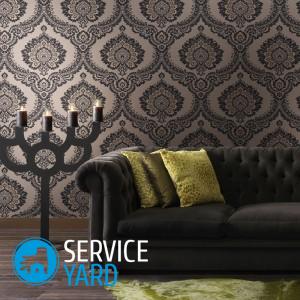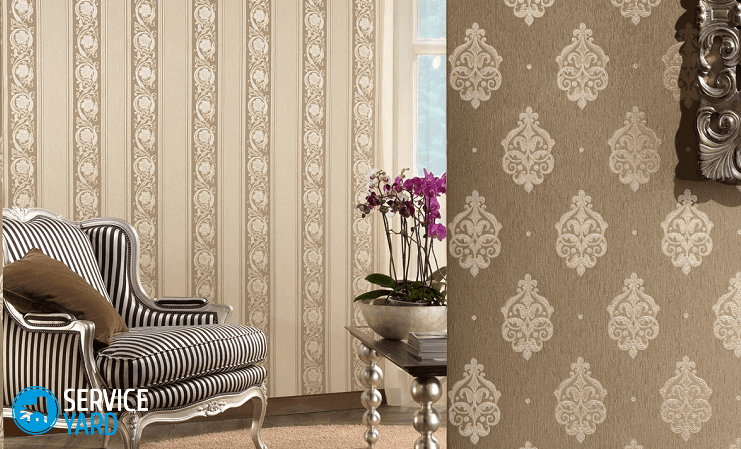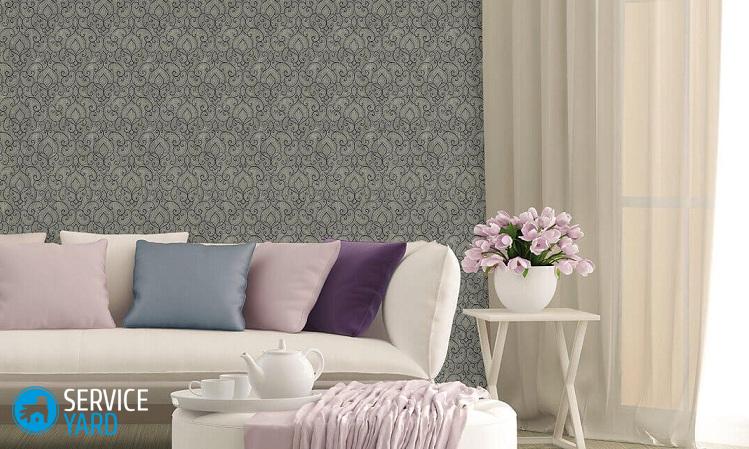How to glue textile wallpaper?

Today, many owners of private houses and apartments use textile wallpapers to create an exquisite interior, as they differ in a pleasant texture, create a feeling of coziness, comfort and warmth. Textile wallpaper is very expensive, and it should be understood that gluing such material must be done very carefully and correctly, since it will cost three times more to fix a marriage with textiles. Today we will tell you how to glue textile wallpapers, introduce them to the rules for sticking them and teach how to care for them.
to contents ↑Varieties of textile wallpaper
A wall covering made of fabric is an excellent option for less visited and less soiled rooms - this is a bedroom or a relaxation room. Textile wallpapers have absolutely any texture, depending on the material used. The structure of the wall covering itself is quite simple:
- Base made of non-woven fabric or paper.
- A layer of fabric running over the base. It is the fabric that is the front side of the wallpaper.
Depending on the fabric used, the coating can be of the following types:
- Flaxseed. The front side is linen fabric. Wallpaper has a high resistance to sunlight.
- Silk. It has the most “rich” appearance.
- Velor Paper is taken as a basis, and a nylon pile is seated on top.
- Felt. This type of coating helps to hide all the bumps on the walls, is resistant to mechanical stress. Wallpaper is safe for human health. Made to order.
- Jute. Wallpaper is resistant to sunlight, helps to hide various bumps on the walls. Among the varieties of jute wall covering, it is worth noting wallpaper intended for painting.
- Synthetic. The textile fabric is glued to foam rubber, which is distinguished by its excellent heat and noise insulation.
On the texture of wall coverings are:
- Layered.
- Smooth.
- Velvety.
The wallpaper gluing procedure depends on both the type of substrate and the type of coating. Glue for fabric wallpaper is selected depending on the basis.
to contents ↑Advantages and disadvantages
We will tell about how to glue textile wallpapers below, and now I want to note the following advantages of this wall covering:
- Unrivaled appearance.
- Excellent performance.
- Good heat and sound insulation.
- Resistance to abrasion and fading.
- Naturalness and environmental friendliness.
Cons of textile coating:
- High price.
- Not suitable for wet cleaning and rubbing with brushes and sponges.
- Immediately absorb moisture and odors, so it is not recommended to use textiles for gluing walls in the bathroom or kitchen.
How to glue textile wallpaper?
Before you begin the process itself, prepare the following tools and materials:
- Textile wallpaper.
- Glue for fabric wallpaper.
- Plaster putty.
- Water based paint.
- Sharp scissors.
- Rubber roller.
- Soft tissue cut.
- Short-haired roller.
- Putty knife.
- Detergent.
- Pencil and tape measure.
- Primer.
- Sandpaper (if necessary).
The process of pasting walls consists of several stages:
- Surface preparation (removal of old paint, alignment of walls, etc.)
- Cut wallpaper and wall layout.
- Wallpapering.
- Drying coating.
Let's consider each stage in more detail.
Wall preparation
Preparation of the surface of the walls should be carried out more carefully, because, unlike the traditional coating, textile wallpapers are so finicky that they will not hang on an uneven wall. In addition, all wall defects are always clearly “demonstrated”.
Important! The surface for sticking should be perfectly clean, even and dry.
To level the walls to perfect condition, proceed as follows:
- Remove the old wallpaper from the wall. Use a spatula and warm water for this.
- Old paint, fiberglass also needs to be removed. If there was an enamel coating on the wall, roughen it with trisodium phosphate.
- Wash the surface of the walls from dust. Use detergent for this purpose.
- Scrape off all the bulges from the walls with a spatula.
- Fill cracks and irregularities.
- Prime the surface using a deep penetration solution.
Important! If the fabric coating has a light tone, then apply a light shade primer to the wall, since the dark primer will shine through and ruin the color scheme.
- Wait for the walls to dry and become hard, clean.
- Apply one coat of water-based paint to the surface of the wall or coat the wall with a couple of layers of primer. This is necessary so that the adhesion of the coating to the wall is the most effective.
Important! Instead of paint and primer, you can use waste linings. Glue the substrate horizontally, otherwise its joints will be visible through the wallpaper.
Cut wallpaper
Before unpacking the rolls, study the correspondence of the article, color, pattern with the sample that you originally selected.
Important! Remember, as soon as you open the roll, from that moment all responsibility for the material passes to you, and you can no longer return the roll or exchange it for a new one. Pay particular attention to the direction of the pile on the fabric.
Cut the wall covering according to the standard scheme:
- Measure the height of the wall.
- Add to allowances up to 5 cm.
- Cut the first blade.
- Cut the second strip into the level with the first, aligning the pattern.
- On the back of each strip, write in pencil the number according to which it will be pasted.
Important! Cut textiles with exceptionally sharp scissors.
After cutting the wallpaper, mark it on the wall with a pencil and a building level. After that, attach the stripes to the wall, check if the patterns match.
Important! Markings on the surface of the wall and stripes of wallpaper do only with a simple pencil, otherwise - spots will remain on the textile.
Glue application
Depending on the basis of the wallpaper, the method of gluing is determined:
- If the coating is non-woven, then glue for fabric wallpaper is applied directly to the wall. So the wallpaper will be less dirty and will not deform after drying.
- If the base is paper, then glue is applied to both the wallpaper and the wall.
Important! Since textile wallpapers require a more scrupulous attitude, use special glue for textiles, which is of high quality and lack of dyes. You can use vinyl glue, which has a low moisture content.
Rules for the use of glue for fabric wallpaper:
- Before applying the adhesive, carefully read the instructions for use - if necessary, dilute it.
- Apply glue to the back of the coating in such a layer as indicated in the instructions.
- Pay special attention to the edges of the paintings, pay attention to the fact that the glue does not appear on the front side.
- After applying the adhesive, allow it to soak (10-15 minutes).
- Fold the strip of wallpaper at this time with the machined sides inward: one side ⅔ of the length, and the other ⅔. As a result, the upper and lower edges will be joined in joint.
- After that, without bending, roll the canvas into a roll and leave it for impregnation.
Sticking process
Room gluing start from the window:
- Step back from the window opening to the width of the strip and draw a vertical line with a pencil.
- Align the first canvas.
- Step back to the ceiling allowance of 2.5-3 cm.
- Attach the first strip approximately in the middle of the wall and start gluing it.
- With a rubber roller, smooth the fabric on the sides and up and down to remove excess air.
- Stick the subsequent strips of wallpaper in the same way. Glue strips exclusively butt. To facilitate gluing, vertically mark the surface of the wall.
- Cut the allowance remaining near the baseboard with a sharp knife.
Important! Smooth textile wallpapers gently, easily pressing on a rubber roller. Do not use a rag or hands for this process.
Advice:
- If glue got on the front side of the coating during operation, clean the surface with a damp cloth (not wet). Remove dirt without friction. After cleaning, blot the area with a dry cloth.
- When gluing fabric wallpaper, the room temperature should be from +18 to +25 degrees, and air humidity - 40%. Watch for moisture on the wall surface - it should be 8%.
- There is the possibility of pasting without seams. Use for this purpose seamless textile fabrics that are glued not vertically but horizontally. The width of some types of such materials reaches 3.1 m, and the length is 100 m.
Important! If you are interested in the question of how to glue textile wallpaper on a non-woven basis, then the process technology is the same as for a paper base, the only difference is that the adhesive is applied only to the wall. There is a positive side to this: the speed of the process increases, the wallpaper remains clean, does not stretch during drying.
Wall drying
To fabric wallpaper completely dried, it takes at least 24-48 hours. The exact time is indicated on the packaging of the adhesive.
to contents ↑Important! All windows, doors should be closed in the room, the air temperature should be constant, in no case should there be drafts.
Textile Wallpaper Care
Care for beautiful fabric wallpaper with care and accuracy, following the following recommendations:
- Remove dust, dry dirt with a vacuum cleaner or a soft brush. Fabric wallpaper is for dry cleaning only.
- Remove small dirt with a damp cloth (not a wet one). A non-concentrated soapy solution or detergent may also be used. Remove dirt without strong friction. After cleaning, blot dry with a dry cloth.
- Use special stain removers for textiles only in extreme cases and only to clean serious dirt in hard-to-reach places.
- Examine the packaging of wall coverings in order to find out about all the properties of wallpaper that they possess. Rare options include wet cleaning.
Stock footage
As you can see, there is nothing complicated in sticking textile wallpapers, although working with them is somewhat more painstaking. We hope that the algorithm of actions given by us and our recommendations helped you to cope with the task, and luxurious, natural textiles will now please you with warmth and comfort.
- How to choose a vacuum cleaner taking into account the characteristics of the house and coatings?
- What to look for when choosing a water delivery
- How to quickly create comfort at home - tips for housewives
- How to choose the perfect TV - useful tips
- What to look for when choosing blinds
- What should be running shoes?
- What useful things can you buy in a hardware store
- Iphone 11 pro max review
- Than iPhone is better than Android smartphones





